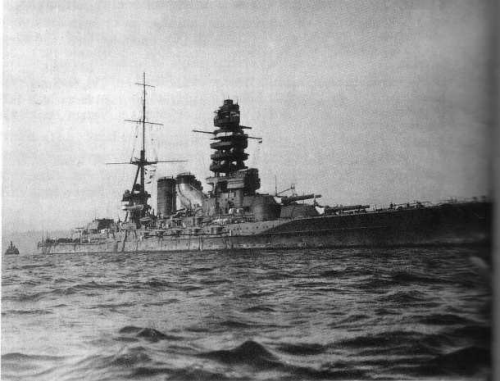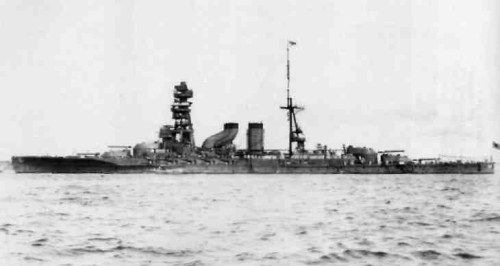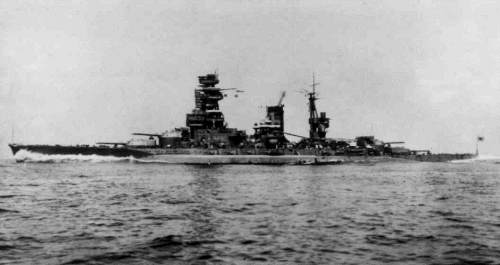
NAVYPEDIA
 Support the project with paypal
Support the project with paypal
Photo
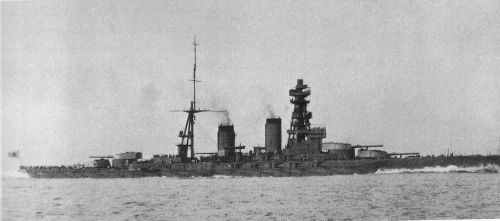
Nagato 1920
Ships
| Name | No | Yard No | Builder | Laid down | Launched | Comp | Fate |
|---|---|---|---|---|---|---|---|
| 長門 [Nagato] | Kure K K | 28.8.1917 | 9.11.1919 | 25.11.1920 | surrendered 9.1945, sunk as target 29.7.1946 | ||
| 陸奥 [Mutsu] | Yokosuka K K | 1.6.1918 | 31.5.1920 | 22.11.1921 | internal explosion 8.6.1943 |
Technical data
| Data variant | as completed | 1938, after modernization |
|---|---|---|
| Displacement standard, t | --- | 39120 |
| Displacement normal, t | 33800 |
|
| Displacement full, t | 38500 | 42850 |
| Length, m | 213.3 wl 215.8 oa |
221.1 wl 224.9 oa |
| Breadth, m | 29.0 |
33.0 |
| Draught, m | 9.10 |
9.49 |
| No of shafts | 4 |
4 |
| Machinery | 4 sets Gihon geared steam turbines, 21 Kampon boilers |
4 sets Kampon-Parsons geared steam turbines, 10 Kampon boilers |
| Power, h. p. | 80000 |
82000 |
| Max speed, kts | 26.5 |
25 |
| Fuel, t | coal 1600 + oil 3400 |
oil 5600 |
| Endurance, nm(kts) | 5500(16) | 8560(16) |
| Armour, mm | belt: 305 - 102, bulkheads: 330 - 254, deck: 51 + 70, barbettes: 305 - 229, turrets: 356 - 127, casemates: 152 - 19, CT: 356 - 102 |
belt: 305 - 102, bulkheads: 330 - 254, deck: 127 + 70, barbettes: 457 - 356, turrets: 457 - 127, casemates: 152 - 19, CT: 356 - 102 |
| Armament | 4 x 2 - 410/45 3-shiki, 20 x 1 - 140/50 3-shiki, 4 x 1 - 76/40 3-shiki, 8 - 533 TT (beam) |
4 x 2 - 410/45 3-shiki, 18 x 1 - 140/50 3-shiki, 4 x 2 - 127/40 89-shiki, 10 x 2 - 25/60 96-shiki, 1 catapult, 3 seaplanes (E7K2) |
| Complement | 1333 |
1368 |
Standard scale images

Nagato 1920
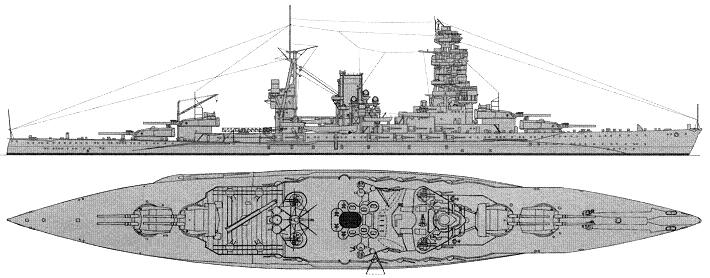
Mutsu 1941
Graphics
Project history
In reply to accepted in the USA in 1916 ambitious shipbuilding program Japanese parliament has approved the so-called "8-4" program, which else since 1914 was tried to conduct by Naval staff. According to it, in addition to ships of classes already ready or being built (Kongo, Fuso and Ise classes) it was provided to build four more battleships. Nagato and Mutsu should become the first Japanese battleships not only built, but also completely designed in Japan. 410mm guns have been developed in Japan in 1914 in reply to occurrence of RN 381mm guns, and also taking into account hearings about works in the USA with heavier guns. Nagato and Mutsu were formed according to the concept of the fast battleship, British Queen Elizabeth class battleships were unique embodiment of this concept at that time, as has predetermined some likeness of these ships though structurally new Japanese battleships "have grown" from Ise class (the same as British from Iron Duke class super-dreadnoughts). The hull, in comparison with previous class, became on 7.6m longer and on 0.3m wider. Abandoning from amidships turrets allowed to place almost twice more powerful machinery, that increased a speed, in comparison with Ise, by 3kts, to 26.5kts.
Already after start of building both ship have moved to the program "8-8", becoming the first of eight battleships and eight battlecruisers with guns in not less than 410mm calibre provided to building. And the last: the Washington conference of 1922 cancelled this program realisation. The fate of Mutsu hung by a thread: it was offered to hand over already ready ship on demolition, but Japanese managed to defend her (in particular, one of arguments was that the part of means for her building was collected by schoolchildren).
Ship protection
Main belt extended from No1 to No4 barbettes and had 305mm thickness between barbettes, tapering to 76mm at lower edge. It closed by 330-254mm fore and 254mm aft bulkheads abreast end barbettes. Hull outside end barbettes was protected by 203mm belt tapered to 76mm at lower edge, thickness of this belt decreased to 102mm near ship ends. Upper 203mm belt extended from main belt to upper deck and from No2 to No3 barbette (110m). It was closed by 203mm angled bulkheads. Lower casemate had 152mm armor. Upper casemate had only 25mm protection. Flat main 70mm deck connected with upper edge of main belt. Lower deck had 51mm thickness in flat part and connected with lower edge of main belt by 76mm slopes. Forecastle deck over casemate was 38-25mm. Turrets had 356mm faces, 280mm sides and 127mm crowns. CT had 356mm sides and 102mm roof. Underwater protection was 6.5m deep and content 76-51mm longitudinal bulkhead.
Ship protection after modernization: 134x3.5m main belt extended from No1 to No4 barbettes and had 305mm thickness between barbettes, tapering to 76mm at lower edge. It closed by 330-254mm fore and 254mm aft bulkheads abreast end barbettes. Hull outside end barbettes was protected by 203mm belt tapered to 76mm at lower edge, thickness of this belt decreased to 102mm near ship ends. Upper 203mm belt extended from main belt to upper deck and from No2 to No3 barbette (110m). It was closed by 203mm angled bulkheads. Lower casemate had 152mm armor. Upper casemate had only 25mm protection. Flat main 70mm deck connected with upper edge of main belt. Lower deck had 127mm thickness in flat part and connected with lower edge of main belt by 76mm slopes. Forecastle deck over casemate was 51mm. Turrets had 457mm faces, 280mm sides and 127mm crowns. CT had 356mm sides and 102mm roof. Underwater protection was 6.5m deep and content 76-51mm longitudinal bulkhead.
Modernizations
1925, Nagato: + 3 x 1 - 76/40 3-shiki
1932 - 1933, Nagato: - 7 x 1 - 76/40; + 4 x 2 - 127/40 89-shiki, 2 x 1 - 40/62 "HI" 91-shiki
1932 - 1933, Mutsu: - 4 x 1 - 76/40; + 4 x 2 - 127/40 89-shiki, 2 x 1 - 40/62 "HI" 91-shiki
(8/1933 - 1.1936, Kure K K) Nagato; (9/1934 - 9.1936, Yokosuka K K) Mutsu: bulges were fitted, hull was lengthened, new boilers were fitted and turbines modernized. Superstructure was reconstructed, fore funnel removed. Maximal angle of main guns elevation increased to 43°, secondary guns from 15° to 35°. 2 140mm guns and all TT were removed, catapult was installed. Protection was partially strengthened.
1938, both: - 2 x 1 - 40/62; + 10 x 2 - 25/60 96-shiki. Data was as given in the table.
6/1943, Nagato: + 1 x 2 - 25/60 96-shiki, 1-shiki 2-go radar
7/1944, Nagato: - 2 x 1 - 140/50, 1 x 2 - 25/60; + 16 x 3 - 25/60 96-shiki, 28 x 1 - 25/60 96-shiki, 2x 3-shiki 1-go, 2x 2-shiki 2-go radars
11/1944, Nagato: - 4 x 1 - 140/50; + 2 x 2 - 127/40 89-shiki, 9 x 3 - 25/60 96-shiki
6/1945, Nagato: - 12 x 1 - 140/50, 6 x 2 - 127/40
Naval service
On Mutsu 8.6.1943 in the Hiroshima bay there was an aft magazines explosion. The principal cause of the explosion which has caused loss of the ship, often a crew negligence is specified.
Nagato during battle in Sibuyan Sea 24.10.1944 has received hits of three bombs which have put out of action one main turret. Next day she was damaged by two more bombs, partially repaired in Yokosuka in the beginning of 1945. The Unique Japanese battleship which has got to winners. 20.9.1945 she was transferred to the USA, used at nuclear tests off the Bikini atoll. 25.7.1946 she was hard damaged by explosion of a 40kt bomb in 1km from the ship and sunk in 4 days.
 HOME
HOME FIGHTING SHIPS OF THE WORLD
FIGHTING SHIPS OF THE WORLD JAPAN
JAPAN CAPITAL SHIPS
CAPITAL SHIPS NAGATO battleships (1920 - 1921)
NAGATO battleships (1920 - 1921)